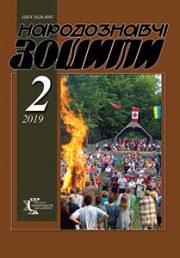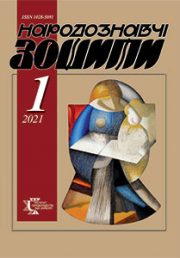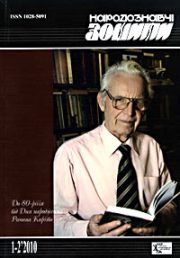The Ethnology Notebooks. 2019, № 3 (147), 698—704
UDK 398.341; 398.4 (477.82/.84)
DOI https://doi.org/10.15407/nz2019.03.698
TRADITIONAL BUILDING RITES OF MANEVYCHI DISTRICT
HALAICHUK Volodymyr
ORCID ID: https://orcid.org/0000-0001-7780-5876
Candidate of Philology, Docent
The Ivan Franko National University of Lviv
Department of Ethnology
1, Universytets’ka str., 79000, L’viv, Ukraine
Contacts: е-mail: halay_czuk@ukr.net
Abstract. The proposed publication examines the traditional building ceremonies of the Manevychi district of the Volyn region. On the basis of expeditionary materials, customs, rituals and demonological representations and beliefs that accompany various stages of building of dwelling and housewarming are considered.
In particular, a number of views discussed in the publication relate to the selection of construction materials. In order not to hurt the people in the new building, for the construction did not use the trees that twisted the storm or broke the lightning, crepe tree, tree with a sprout from the core («candle»), trees on two trunks («twins»), that grew in the cemetery; also not built of aspen.
Unfavorable homes recognize the places of former burials or those that are in dispute, also did not build on former boundaries or roads, on the old «okapin», did not erect a new home around the old one. By some means, they searched for a «warm» place for the house, preferably on their own land.
At the huts of the house everywhere practiced laying on the foundations of money to provide wealth in the house, as the apotropians put sacred herbs and incense. An important role in lending was played by the person of the wizard, so «healers» tried not to hire. Somewhere in the place where the table is standing, a crochet was tied up. The structure was completed by installing on the rafters a «wreath» («bouquet», «flowers»).
To have plenty in the house, a cat or a cock, a chicken, sometimes a dog was allowed to go in there in front of the entrances. There are references to invitations to a new dwelling house. On the inside of the first man came to the house as the owner of the house. Ritual function in this rite was bread.
It was stated that the construction ritual of Manevychi district corresponds to the ritual of other western regions, because it is based on the same realities and expresses identical motives.
Keywords: Western Polissya, Manevychi district, construction ceremonial, institutions, entrances, hobgoblin.
Received 10.05.2019
REFERENCES
Archive DNCZKSTK. F. Manevychi-2016. Op. save V. Halaichuk [in Ukrainian].
Siletskyi, R. (2011). Traditional building rites of Ukrainians. Lviv: The Ivan Franko National University of Lviv [in Ukrainian].






